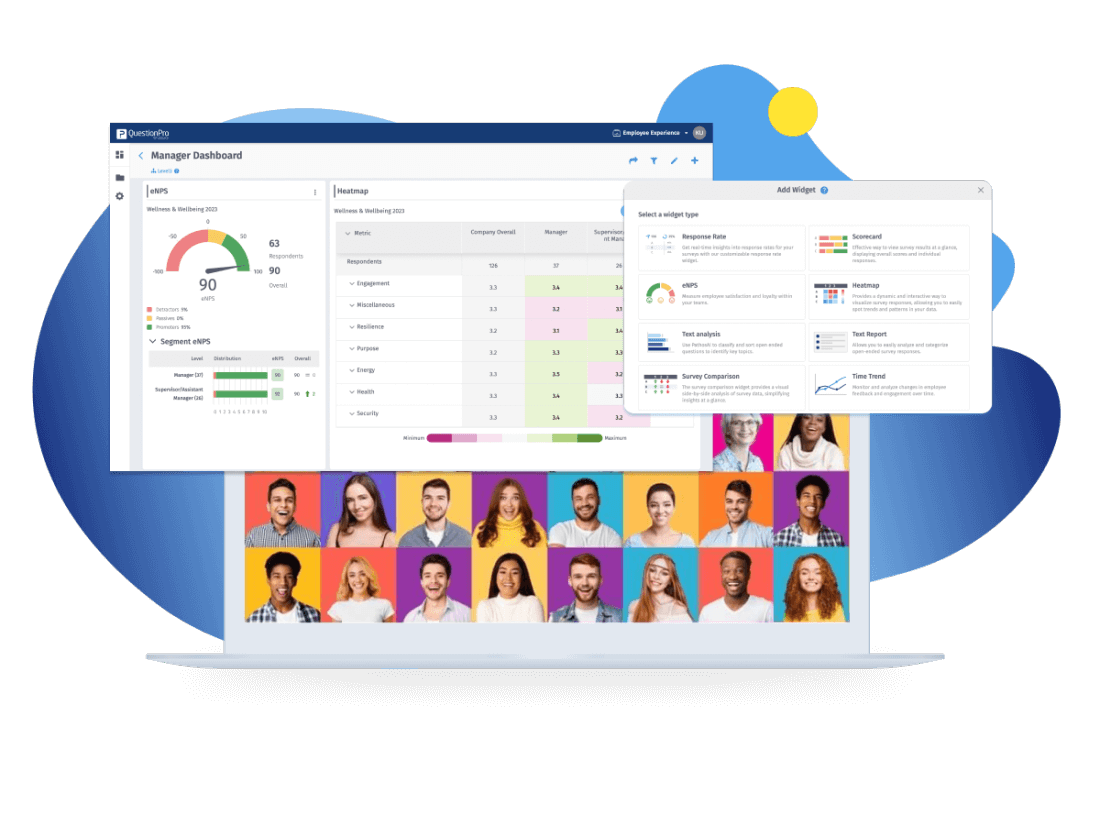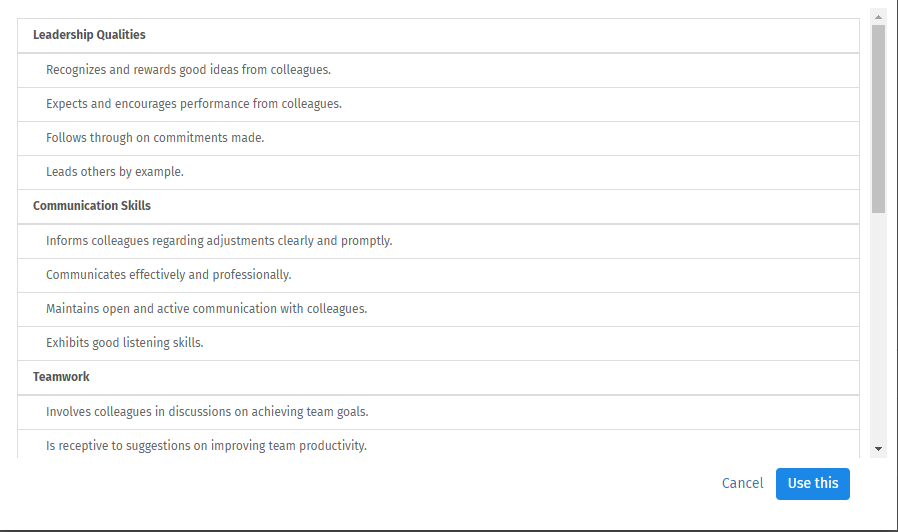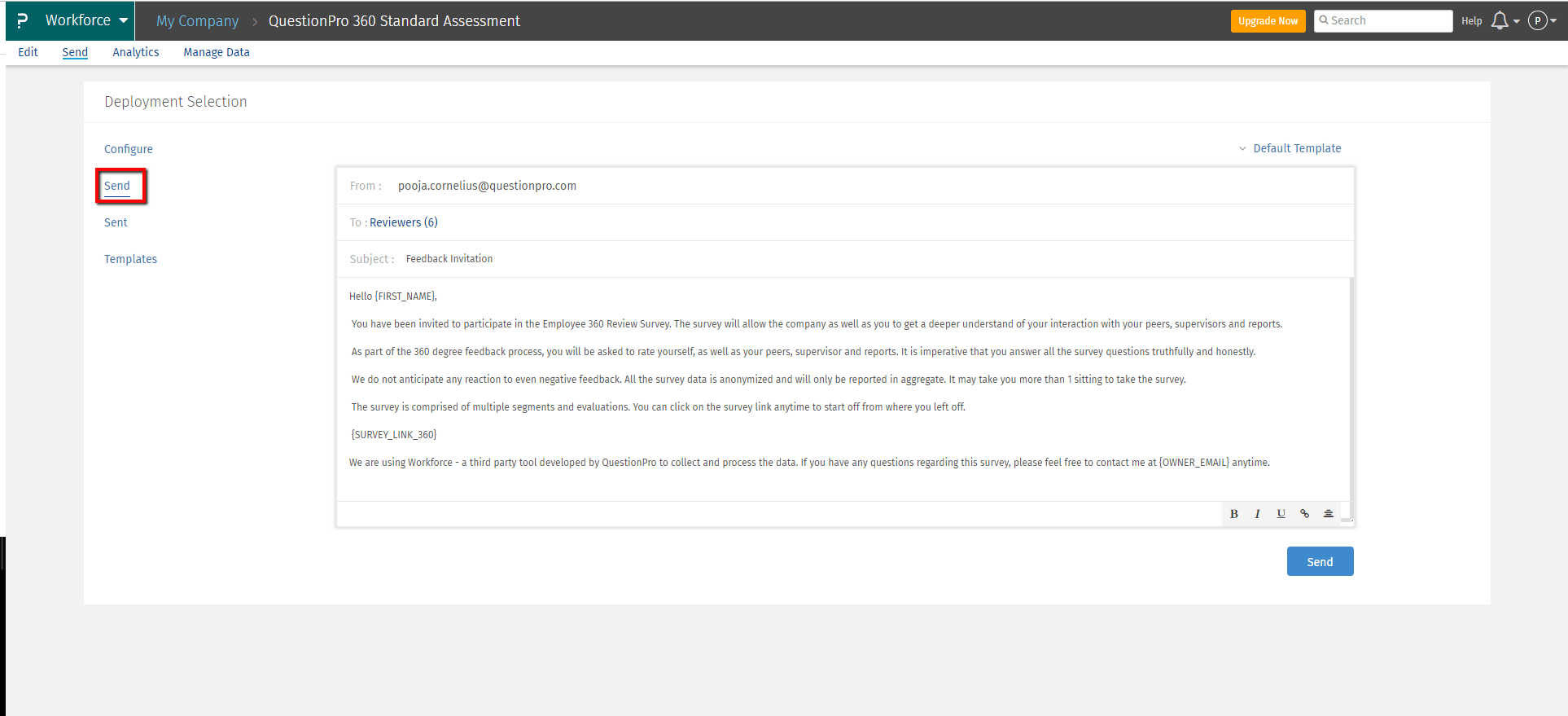Employee feedback is giving updates and suggestions for improving an employee’s performance. Depending on the feedback mechanism you follow, this can be from managers only or also from subordinates, peers, and customers. Some organizations follow traditional performance review methods where only managers provide feedback, whereas others adopt a 360-degree review where multiple stakeholders offer updates.
Employee feedback is provided at regular intervals to help improve their performances. The feedback may be more effective and updated if the interval is shorter. Continuous performance management helps provide constructive feedback that helps manage better training needs, goals, etc. Assisting employees to grow professionally and personally ensures they are engaged and satisfied.
Employee feedback can be positive or negative, depending on the employee’s performance. In either case, it has to be effectively communicated to the employee to be useful. Employees need to understand it, agree to it, and willingly act on it.
Here are the top 5 ways to convey employee feedback effectively:
- Be specific: Quite often, employee feedback is delivered in generic terms. Inputs such as ‘your work has been good or bad’ are too vague. They do not highlight specific tasks, aspects, or areas and are not helpful. When delivering feedback, be specific. It should be like, ‘Your work on this project helped us close a deal,’ ‘Your initiative on this assignment helped uncover blind spots,’ etc. You get the idea. Specificity is key.
- Meet in person with the employee: Do not deliver feedback in team meetings or group forums. This could be more effective and may embarrass the employee. Have a one-on-one meeting, dedicate some time, collect points, and put these points forward in your discussion. Put something on the calendar and meet as often as possible.
- End with positives: Feedback can be positive, negative, or both. Not all feedback can be good or bad. You can certainly end on a positive note, though. Keep all the positives toward the end; let them know how that helped the organization, the team, or colleagues. Employees need to see the organization appreciates them and their efforts.
- Be performance-specific: When delivering feedback, managers or peers often focus on employee traits and behaviors. Employee feedback has to be about tasks and projects. Avoid discussing aspects such as ‘your attitude,’ ‘your reluctance,’ etc.
- Be receptive: Employee feedback must be a two-way street. You have to give feedback, but you also have to listen to the employee. Understand their concerns, the reasons behind their lack of performance or delays, their training requirements, etc.
Employee feedback is an organization's health check-up, used to understand its organizational health index (OHI) and measure employee engagement and employee satisfaction.
Employee feedback software is a tool that helps organizations streamline their feedback process. It aids organizations in providing regular feedback to their workforce to ensure their constant growth and development.
The platform collates and stores all employee performance data, which is handy when looking at historical data, sharing it with other reviewers, etc. The tool provides functionality and features such as report sharing, custom dashboards, role-based access, data privacy, etc.
Each platform offers unique features and benefits, allowing organizations to choose the one that best suits their needs. These tools enhance employee engagement, improve workplace culture, and provide actionable insights for organizational growth.
Here's a more detailed overview of the 10 best employee feedback software tools, highlighting their key features and benefits:
01. QuestionPro Workforce
QuestionPro Workforce is an employee feedback platform that captures real-time employee engagement and satisfaction insights. This tool helps organizations create surveys, conduct 360-degree feedback, and gather data on employee experiences.
Key Features:
- 360-Degree Feedback: Collects feedback from peers, managers, and subordinates.
- Real-time Analytics: Offers dashboards and reports to analyze data instantly.
- Customizable Surveys: Enables users to design surveys tailored to specific needs.
- Employee Pulse Surveys: Regularly measure employee engagement and satisfaction.
Benefits:
- Improves employee engagement by addressing concerns promptly.
- Enhances decision-making through data-driven insights.
- Boosts employee retention by identifying and mitigating potential issues.
02. ContactMonkey
ContactMonkey is an innovative feedback tool that integrates directly with email platforms like Outlook and Gmail. It focuses on internal communication and employee engagement, allowing organizations to gather feedback seamlessly through email interactions.
Key Features:
- Email Tracking: Monitors open rates and engagement with internal emails.
- Employee Surveys: Embeds surveys directly into emails for accessible feedback collection.
- Interactive Newsletters: Engages employees with clickable content and polls.
- Real-time Analytics: Provides insights into employee interactions with communications.
Benefits:
- Increases engagement by reaching employees through familiar channels.
- Provides actionable insights into internal communication effectiveness.
- Facilitates immediate feedback collection without requiring separate tools.
03. 15Five
15Five is a continuous performance management and feedback tool designed to enhance communication between employees and managers. It focuses on goal setting, performance reviews, and regular check-ins to foster a culture of continuous improvement.
Key Features:
- Weekly Check-ins: Encourages regular communication between employees and managers.
- OKRs (Objectives and Key Results): Helps align individual goals with company objectives.
- Performance Reviews: Offers tools for comprehensive performance evaluations.
- Employee Recognition: Provides features for peer recognition and appreciation.
Benefits:
- Boosts productivity by aligning individual goals with organizational objectives.
- Enhances communication and trust between employees and management.
- Drives continuous improvement through regular feedback and recognition.
04. Officevibe
Officevibe is an employee engagement software that helps organizations gather feedback through pulse surveys and measure workplace culture. It focuses on creating a positive work environment by understanding employee needs and concerns.
Key Features:
- Pulse Surveys: Conduct regular surveys to gauge employee sentiment.
- Feedback Tools: Allows employees to provide anonymous feedback and suggestions.
- Engagement Metrics: Offers insights into key engagement areas like satisfaction and alignment.
- Customizable Reports: Provides detailed reports for data-driven decision-making.
Benefits:
- Fosters a positive work culture by addressing employee concerns.
- Enhances employee engagement surveys through regular feedback loops.
- Fosters a positive work culture by addressing employee concerns.
05. TINYpulse
TINYpulse is a simple yet powerful feedback tool that focuses on collecting employee feedback through quick pulse surveys. It aims to improve employee engagement and satisfaction by regularly measuring workplace happiness.
Key Features:
- Pulse Surveys: Sends weekly surveys to gather quick insights into employee mood.
- Peer Recognition: Encourages peer-to-peer appreciation and recognition.
- Anonymous Feedback: Allows employees to share candid thoughts anonymously.
- Engagement Insights: Provides metrics on employee satisfaction and engagement.
Benefits:
- Increases employee satisfaction by addressing concerns swiftly.
- Enhances workplace culture through regular recognition and appreciation.
- Promotes transparency and trust with anonymous feedback options.
06. Energage
Energage is a comprehensive employee engagement platform that focuses on building a strong workplace culture through continuous feedback and analytics. It offers tools for measuring engagement, recognizing top performers, and driving cultural transformation.
Key Features:
- Engagement Surveys: Conduct surveys to assess employee satisfaction and alignment.
- Culture Analytics: Provides insights into cultural strengths and areas for improvement.
- Employee Recognition: Supports recognition programs to celebrate achievements.
- Benchmarking Tools: Compares organizational performance against industry standards.
Benefits:
- Strengthens organizational culture by identifying and addressing cultural gaps.
- Boosts employee engagement through targeted recognition programs.
- Improves decision-making with actionable insights and benchmarking data.
07. SurveyMonkey
SurveyMonkey is a versatile survey platform that offers tools for creating and distributing employee feedback surveys. With its user-friendly interface and robust analytics, it helps organizations collect and analyze feedback effectively.
Key Features:
- Survey Templates: Provides pre-designed templates for various feedback scenarios.
- Customizable Surveys: Allows users to design surveys tailored to specific needs.
- Data Analytics: Offers tools for analyzing survey results and identifying trends.
- Integration Capabilities: Integrates with other tools for seamless data sharing.
Benefits:
- Simplifies feedback collection with easy-to-use survey templates.
- Enhances decision-making with detailed analytics and reporting.
- Increases engagement by regularly soliciting employee feedback.
08. Trakstar
Trakstar is a performance management tool with feedback tools for enhancing employee performance and engagement. It offers performance reviews, goal setting, and 360-degree feedback to support continuous development.
Key Features:
- Performance Reviews: Facilitates comprehensive performance evaluations.
- 360-Degree Feedback: Collects feedback from peers, managers, and subordinates.
- Goal Setting: Aligns individual goals with organizational objectives.
- Analytics Dashboard: Provides insights into performance trends and areas for improvement.
Benefits:
- Drives continuous improvement through regular performance evaluations.
- Aligns individual performance with company goals for increased productivity.
- Enhances employee engagement with comprehensive feedback mechanisms.
09. Culture Amp
Culture Amp is an employee feedback and analytics platform that improves workplace culture and employee engagement. It offers tools for gathering feedback and measuring employee experiences.
Key Features:
- Engagement Surveys: Assess employee satisfaction and engagement levels.
- Feedback Tools: Facilitate continuous feedback and communication.
- Analytics Dashboard: Provides insights into engagement trends and areas for improvement.
- Customizable Surveys: Customize surveys to specific organizational needs.
Benefits:
- Improves workplace culture through continuous feedback.
- Provides actionable insights for enhancing employee engagement.
- Supports data-driven decision-making through detailed analytics.
10. CultureMonkey
CultureMonkey is an employee engagement platform that improves workplace culture through regular feedback and insights. It offers tools for measuring employee satisfaction and aligning company values with employee experiences.
Key Features:
- Pulse Surveys: Frequent surveys to assess employee sentiment and engagement.
- Feedback Tools: Facilitate continuous feedback and communication.
- Engagement Reports: Provide insights into engagement trends and areas for improvement.
- Customizable Surveys: Create surveys for specific organizational needs.
Benefits:
- Enhances workplace culture through continuous feedback.
- Increases employee engagement with regular check-ins.
- Provides actionable insights for improving employee experience.
Several employee feedback software are available in the market for you to choose from. It can take time to choose the one that best suits your requirements. Apart from budget and integration capabilities, here are some things you should consider when buying the right employee feedback tool.
- Know your requirements: This might seem to be the most straightforward task; however, this is the most tricky part! You need to choose the right fit for your organization. It's as important as choosing a life partner (pun intended). First, you must ask a few questions: how often do you conduct feedback sessions? How engaging do you want your surveys to be? What do you plan to do with the data, and so on? List your priorities before shortlisting anything.
- Ease of use: If the employee feedback software takes you forever to learn and use, you are in trouble. You need people-friendly software that is easy to use and quick to learn. Before you go ahead and finalize, make sure you get support tutorials and documents.
- Price range: You may have to choose wisely depending on your organization’s size and requirements. Looking for employee feedback software that offers a variety of subscriptions will be a better fit than rigid ones. Also, refer to the refund policies. The budget mustn’t get tossed out of the window.
- Automation options:QuestionPro Workforce allows you to automate your employee feedback software. Traditionally, HR makes numerous attempts to remind people to complete the surveys. The more automation the software permits, the easier it is for the organization. You can automate and schedule the surveys.
- Aim for higher survey completion: Surveys are an excellent employee feedback mechanism. They’re convenient and easy, and the data is stored centrally. Survey fatigue is real! An estimated 58% of people don’t complete the entire survey due to its length. You must keep the survey length appropriate. The user interface is often the last thing anyone would bother with; however, ask yourself, do your completed surveys look presentable?
Employee feedback software offers numerous benefits for organizations and their employees, making it a valuable tool in today’s workplace. Here are some key advantages of using employee feedback software:
- Enhanced Communication: Employee feedback software facilitates open communication between employees and management. It provides a platform for employees to voice their opinions, share ideas, and provide feedback in real-time, leading to more transparent and effective communication.
- Improved Employee Engagement: Regular feedback helps employees feel valued and heard, which boosts their morale and engagement. By actively participating in the feedback process, employees are more likely to be motivated and committed to their work, leading to higher productivity and job satisfaction.
- Data-Driven Decision Making: The software collects and analyzes data from employee feedback, providing valuable insights into employee sentiments and workplace issues. This data-driven approach enables managers to make informed decisions and implement strategies that align with employee needs and organizational goals.
- Increased Productivity: By identifying areas of improvement through feedback, organizations can address issues that may hinder productivity. When employees see their feedback leading to positive changes, they are more likely to put in extra effort, resulting in increased productivity and efficiency.
- Better Employee Retention: Engaged and satisfied employees are less likely to leave an organization. Analyze employee feedback tools to help identify potential issues before they escalate, allowing managers to proactively improve the work environment and retain top talent.
- Continuous Improvement: The software fosters a culture of constant improvement by regularly collecting feedback and tracking progress over time. Organizations can use this feedback to refine processes, enhance employee experiences, and maintain a competitive edge in the market.
- Anonymity and Honesty: Many feedback platforms offer anonymity, encouraging employees to share honest opinions without fear of repercussions. This leads to more genuine and actionable feedback, which can be used to drive meaningful changes in the workplace.
Employee feedback software is a powerful tool that enhances organizational performance by promoting open communication, increasing employee engagement, and enabling data-driven decision-making.
QuestionPro Workforce is a platform that offers end-to-end employee review software solutions. It is your one-stop shop for all employee surveys, people analytics, and reporting. It is easy to use and comprehensive. You can start just by clicking a button. Here are the steps:
Step 1: Login to QuestionPro >> Workforce
Step 2: Choose from a range of pre-designed employee feedback surveys
Step 3: Select from a wide range of survey question to best suit your employee feedback process
Step 4: Deploy the employee feedback survey at the click of a button. You can also automate the process and schedule the survey
Step 5: Collect responses and compare the analytics year on year
Create your free Workforce account today and start conducting surveys. Take a step towards improving your people processes.
Survey Software Easy to use and accessible for everyone. Design, send and analyze online surveys.
Research Suite A suite of enterprise-grade research tools for market research professionals.
Customer Experience Experiences change the world. Deliver the best with our CX management software.
Employee Experience Create the best employee experience and act on real-time data from end to end.

















